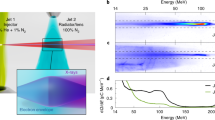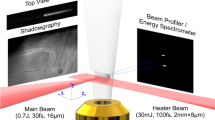Abstract
Electron Cyclotron Emission (ECE) of different frequencies originates at different locations in non-uniformly magnetized plasmas. For simultaneous observation of multiple ECE frequencies from the outside edge of a toroidal plasma confinement device (e.g. a tokamak), the focal length of the collecting optics should increase with the frequency to maximize the resolution on a line of sight along the magnetic field gradient. Here we present the design and numerical study of a zoned metamaterial lens with such characteristics, for possible deployment with the 83–130 GHz ECE radiometer in the DIII-D tokamak. The lens consists of a concentric array of miniaturized element phase-shifters. These were reverse-engineered starting from the desired Gaussian beam waist locations and further optimized to account for diffraction and finite-aperture effects that tend to displace the waist. At the same time we imposed high and uniform transmittance, averaged over all phase-shifters. The focal length is shown to increase from 1.32 m to 2.08 m over the frequency range of interest, as desired for low-field DIII-D discharges (B = −1.57 T). Retracting the lens to receded positions rigidly moves the waists accordingly, resulting in a good match—within a fraction of the Rayleigh length—of the EC-emitting layer positions at higher fields (up to B= −2.00 T). Further, it is shown how varying the lens aperture might move the waists “non-rigidly” to better match the non-rigid movement of the EC-emitting layers with the magnetic field. The numerical method presented is very general and can be used to engineer any dependence of the focal length on the frequency, including zero or minimal chromatic aberration.









Similar content being viewed by others
References
M. Bornatici, R. Cano, O. de Barbieri, F. Engelmann, Nuclear Fusion 23(9), 1153 (1983)
W.H.M. Clark, Plasma Physics 25(12), 1501 (1983)
J.L. Luxon, Nuclear Fusion 42, 614 (2002)
R.F. Ellis, M.E. Austin, D. Taussig, in Proceedings of the 14th Joint Workshop on Electron Cyclotron Emission and Electron Cyclotron Resonance Heating (EC 14) (2006)
M. Born, E. Wolf, Principles of Optics, 6th edn. (Cambridge University Press, 2006)
D.R. Smith, J.J. Mock, A.F. Starr, D. Schurig, Physical Review E 71 (2005)
R.B. Greegor, C.G. Parazzoli, J.A. Nielsen, M.A. Thompson, M.H. Tanielian, D.R. Smith, Applied Physics Letters 87 (2005)
T. Driscoll, D.N. Basov, A.F. Starr, P.M. Rye, S. Nemat-Nasser, D. Schurig, D.R. Smith, Applied Physics Letters 88 (2006)
H.F. Ma, X. Chen, H.S. Xu, X.M. Yang, W.X. Jiang, T.J. Cui, Applied Physics Letters 95 (2009)
K. Sarabandi, N. Behdad, IEEE Transactions on Antennas and Propagation 55(5), 1239 (2007)
L. Zhang, G. Yang, Q. Wu, J. Hua, IEEE Transactions on Magnetics 48(11), 4534 (2012)
W.J. Capecchi, N. Behdad, F.A. Volpe, Optics Express 20(8), 8761 (2012)
M.G. Silveirinha, Physical Review Letters 102(19), 193903 (2009)
M.A. Al-Joumayly, N. Behdad, IEEE Transactions on Antennas and Propagation 59(12), 4542 (2011)
M.A. Al-Joumayly, N. Behdad, IEEE Transactions on Antennas and Propagation 58(12), 4033 (2010)
P.F. Goldsmith, Quasioptical Systems: Gaussian Beam Quasioptical Propagation and its Applications (IEEE Press, 1998)
J.P. Tetienne, R. Blanchard, N. Yu, P. Genevet, M.A. Kats, J.A. Fan, T. Edamura, S. Furuta, M. Yamanishi, F. Capasso, New Journal of Physics 13, 053057 (2011)
Author information
Authors and Affiliations
Corresponding author
Appendix A: Choosing Target Functions
Appendix A: Choosing Target Functions
The target functions \(\phi _{t}(n,f)\) were chosen according to the following steps:
-
1.
For every unique pair \(\{a,b\}\) database unit cells, compute the difference in \(\delta \phi \) at each of the benchmark frequencies; in other words, find \(\delta \phi _{b}(f_{i}) - \delta \phi _{a}(f_{i})\).
-
2.
Compute the following sum over the six benchmark frequencies \(f_{i}\) Table 1:
$$ \chi_{\{a,b\}}^{2} = \sum\limits_{i}[(\delta\phi_{b}(f_{i})-\delta\phi_{a}(f_{i}))-\Delta\phi(83,f_{i})]^{2} $$(10)where \(\Delta \phi \), defined in Eq. 4, signifies the difference in phase advance between the outermost zone (83) and the innermost zone (1) at frequency \(f_{i}\).
-
3.
Identify the pair \(\{a ,b^{*}\}\) for which \(\chi ^{2}\) is the lowest. Choose as the initial target phase distribution the following:
$$ \phi_{t_{1}}(1,f_{i}) = \delta\phi_{a^{*}}(f_{i}) + \frac{[\delta\phi_{b^{*}}(f_{i})-\delta\phi_{a^{*}}(f_{i})] - \Delta\phi(83,f_{i})}{2} $$(11) -
4.
Use as the remaining target phase distributions \(\phi _{t_{k}}\) the set:
$$ \phi_{t_{k}}(1,f) = \begin{cases}\phi_{t_{1}}(1,f_{1}) + \theta_{1} &\mbox{if } f = f_{1} \\\phi_{t_{1}}(1,f_{2}) + \theta_{2} &\mbox{if } f = f_{2} \\\phi_{t_{1}}(1,f_{3}) + \theta_{3} &\mbox{if } f = f_{3} \\\phi_{t_{1}}(1,f_{4}) + \theta_{4} &\mbox{if } f = f_{4} \\\phi_{t_{1}}(1,f_{5}) + \theta_{5} &\mbox{if } f = f_{5} \\\phi_{t_{1}}(1,f_{6}) + \theta_{6} &\mbox{if } f = f_{6}\end{cases} $$(12)where \(\theta _{1},\theta _{2},\theta _{3},\theta _{4},\theta _{5},\theta _{6}\) can take the values \(0, \pm 4\)°, and \(\pm 8\)°. This will lead to \(6^{5}\) unique \(\phi _{t_{k}}\) functions.
Rights and permissions
About this article
Cite this article
Hammond, K.C., Massidda, S.D., Capecchi, W.J. et al. Metamaterial Lens of Specifiable Frequency-Dependent Focus and Adjustable Aperture for Electron Cyclotron Emission in the DIII-D Tokamak. J Infrared Milli Terahz Waves 34, 437–455 (2013). https://doi.org/10.1007/s10762-013-9987-1
Received:
Accepted:
Published:
Issue Date:
DOI: https://doi.org/10.1007/s10762-013-9987-1




